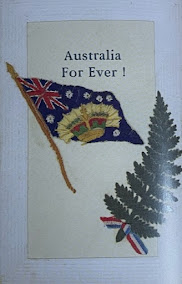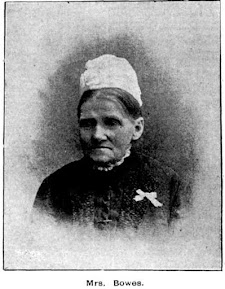A Sense of Fervour!
But when did people who call Australia "home" actually start to feel a sense of pride to be called an Australian?
The various states of Australia were federated on 1st January 1901, but I would argue that Australia did not have a fervour for unity as a nation until the mid-point of WW1. At that stage, after the atrocities of The Great War that Australians took part in, firstly Gallipoli and then the Battles of Fromelles and Pozieres, did people begin to question the need to send their sons to a war so far away only seemingly to decimate their youth.
Photographs of Australian soldiers taken overseas often show them wearing homemade maps of Australia on their wrists. Many of the crosses on Military gravesites depict the Australian map and many postcards from overseas show the use of an Australian map. To me, this shows a fervour for Australia. Perhaps many had begun to develop a strong sense of identity as belonging to another country and not "Mother England" as many referred to Great Britain prior to the outbreak of WW1.
Photo from State Library of Victoria website
Example of use of map of Australia on Grave marker - from the Thuiller collection of glass plate negatives AWM
Detail from a photo from the Thuiller collection of glass plate negatives showing bracelet in shape of Australia
Some of this fervour is displayed on a number of headstones located throughout Rookwood but mostly in Section 5 of the Anglican area. They were erected as memorials for sons killed in The Great War after 1916 who would never come home.
Here are a few stories behind those headstones.
CHARLES AND ERNEST SHIPWAY
Ernest the elder brother at the age of 28 enlisted on 1st October 1915 as a gunner and was soon joined by his younger 21-year-old brother Ernest. Charles had two years previous military service and enlisted as a Sergeant.
They sailed from Sydney on board the HMAT A8 Argyllshire on 11th May 1916 - straight to the fields of France.
As part of the 26th Battalion they fought in its first major battle around Pozieres in July/August. After a short spell in Belgium, the 2nd Division headed south in October to attack in the Somme Valley. The 26th Battalion took part in two attacks to the east of Flers, both of which floundered in mud and slush.
Later that year the focus of the AIF's operations switched to Belgium.
On the 17th of September 1917 the brothers were sitting together partaking of breakfast in the wagon lines at Dickebusch when a German shell burst among the troops and took 45 casualties, 8 were killed and 3 later died from wounds received. Charles took the full force of the shell blast and was horrifically injured. The first casualty that Ernest came across was that of the body of his brother. Ernest was badly affected by shell shock and no doubt by the horror of witnessing his brother's physical damage.
Charles is buried in the Huts Cemetery in Belgium. Ernest somehow made it to the end of the war, returning to Australia on 11th May 1919. He died in May 1970 and was cremated at the Northern Suburbs Crematorium.
Shipway headstone - author's own
FREDERICK CHARLES MERCHANT AND FREDERICK WILLIAM THORNTON
Frederick Charles (listed as Marchant in NAA files) enlisted on 14th February 1916. He was 21 and was employed as a ship trimmer. He sported a tattoo of a Kangaroo and the Australian Flag on his right arm.
It appears that soon after he joined, during training, he suffered a hernia and needed hospitalisation. Just as he went back into training, he contracted pneumonia and died at his home in Soudan Street Granville after having a cardiac arrest. He had just turned 22 and never fired a shot in anger.
His cousin, Frederick William was employed as a butcher at the time of the outbreak of WW1 and enlisted 4 days after his cousin. He went AWOL in Fremantle when his troop ship docked and was reported missing. Frederick was later found, suffered the consequences and transferred to the 11th Battalion from the 9th of March sailing to France and the Western Front. The Battalion saw action at Pozieres in July. After that Battle the battalion manned trenches near Ypres in Flanders before returning to the Somme valley for winter.
Early in 1917 during freezing conditions, Frederick became quite ill and died in the Field Hospital of Cerebro Spinal Meningitis, a disease caused by bacteria and in his case proved fatal.
Frederick is buried at Heilly Station Cemetery in France.
Merchant and Thornton headstone - author's own
HORACE JOHN HARRIS GODBOLD
Horace was born in 1898 the youngest child of Herbert and Susannah Godbold.
Horace enlisted in May 1918 and his enlistment papers show he was born in Bowling Alley Point near Tamworth in regional NSW and employed as a Farmer. The enlistment papers also show he was 19 years and 11 months at the time and needed his father's signature to join up. He mother had died in 1912.
Whilst in training at the Liverpool, western Sydney camp in September he was admitted to the nearby hospital suffering with meningitis. He seems to have been passed fit to commence training again in July 1918. Horace took a turn for the worse and was transported to the Garrison Hospital at the Victoria Barracks Paddington where he died on 23rd November 1918 from cardiac failure following celebro spinal meningitis from which he had been suffering for some 15 weeks. He was only 20 years of age.
Another soldier who never fired a shot in anger.
His headstone which is hard to read is inscribed with "my son and our brother."
Godbold headstone - author's own
As you can see from the photographs of the headstones that strong sense of nationalism emerging.
May they Rest in Peace. They fought for our freedom.
For this information I have utilised records from the National Archives (NAA), AMW (Australian War Memorial) records. I also sourced some information from the excellent book by Ross Coulhart, "The Lost Diggers" - a book worth getting a copy of regarding Australia's contribution to WW1 and previously lost photographs of "Aussie Diggers."
If you wish to add any comments, please do so below if you have access to Blogspot or go to the group facebook page by searching under
rookwoodcemeterydiscoveries
or simply send me an email at
lorainepunch@gmail.com









A very interesting post.🌅 “Remembered”
ReplyDeleteI really admired their fervour for Australia
Delete